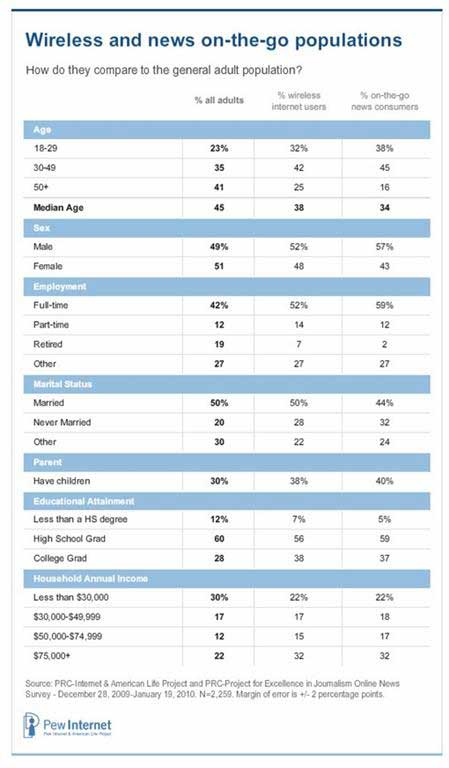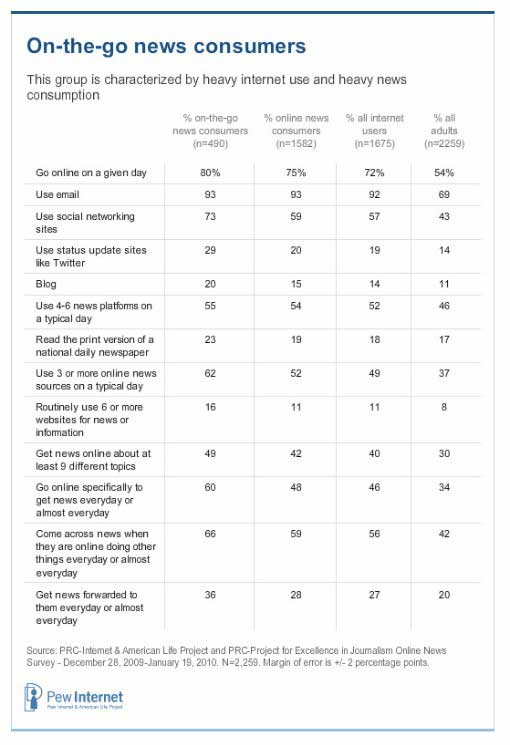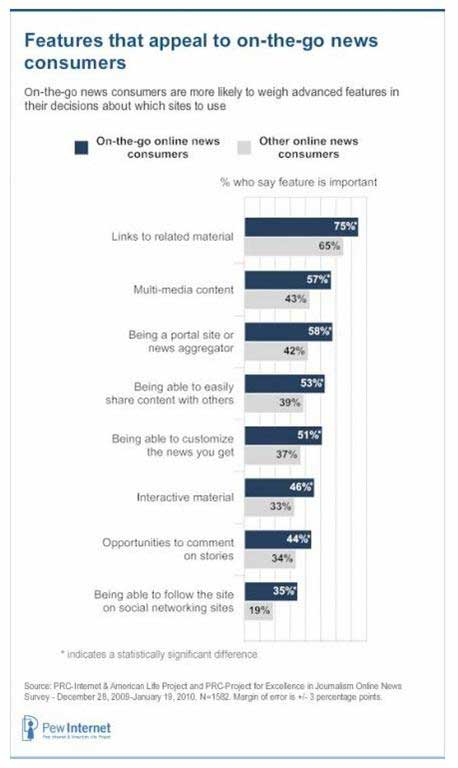Over one-third (37%) of adult cell phone owners are the "on-the-go" mobile news consumers—that is, voracious readers of online news who use their mobile phones to access news content more frequently, and from a greater number of news platforms, than the typical online news consumer—according to a survey from Pew.
Among mobile Internet activities, 72% of on-the-go news consumers check weather and related information using their cell phones, and 68% get news and current events.
Other mobile Internet activities performed via cell phone by the on-the-go segment include the following:
- Downloading an application that enables access news, weather, sports, or other information: 49%
- Checking sports scores and related information: 44%
- Checking traffic reports: 35%
- Receiving financial information or updates: 32%
- Receiving news alerts by text or email: 31%
Below, other findings from the survey Understanding the Participatory News Consumer from the 2010, issued by the Pew Research Center's Internet & American Life Project and Project for Excellence in Journalism.
The typical on-the-go news consumer is a white male, age 34, who is a college graduate with a full-time job. Nearly one-third (32%) of on-the-go news consumers live in households with annual incomes of $75,000 or more, and 40% are parents of young children (compared with 30% of the general adult population).

Higher Internet and News Consumption
On-the-go news consumers are especially heavy Internet users: 80% are online on any given day, compared with 72% of all Internet users, and they engage in various online activities at significantly higher rates than other Internet users, including blogging (20% vs. 14%), using social networking sites (73% vs. 57%), and using status update sites like Twitter (29% vs. 19%).

More than one-half (55%) of on-the-go news consumers use 4-6 news platforms on a typical day. They are also more likely than other Internet consumers to access news from three or more online sources daily (62% vs. 49%) and read the print version of a national newspaper (23% vs. 17%).
The only news platform they are less likely than other adults to use on a typical day is their local television news, and that difference is only slight.
Looking for great digital marketing data? MarketingProfs reviewed more than 200 research sources and selected 64 of the best to create the Digital Marketing Factbook a 144-page compilation of data and 110 charts, covering email marketing, search engine marketing, and social media. Also check out The State of Social Media Marketing, a 240-page original research report from MarketingProfs.
Putting On-the-Go News to Use
On-the-go news consumers tend to put the information they find online to practical use, and they are twice as likely as other adults to say they follow the news for their jobs (30% vs. 15%).
In addition, on-the-go news consumers are more likely than other adults...
- To say they seek information in the news that improves their lives (66% vs. 59%)
- To enjoy talking about the news with their friends and family (77% vs. 70%)
- To see bias in most news sources today (78% vs. 69%)
- To follow news only about specific topics that interest them (34% vs. 26%)
Nearly two-thirds (65%) of on-the-go consumers say it is easier to keep up with news and information today than it was five years ago; only 14% believes it is harder to keep up with news today.
Features that Appeal to On-the-Go Consumers
Asked to consider the most important features they look for in news websites, on-the-go news consumers are more likely than other online news consumers to cite advanced features, including links to related material (75% vs. 65%), multimedia content (57% vs. 43%), portal news sites or aggregators (58% vs. 42%), and the ability to share content with others (53% vs. 39%).

In addition, on-the-go consumers are especially likely to contribute material or actively share it with others: 46% of them are "news participators"—a group that engages in one of the following activities:
- Tagging or categorizing online news content
- Contributing a user-generated article, opinion piece, picture, or video to an online news site
- Commenting on a news story or blog they read online
- Posting a link to a news story or blog on a social networking site
- Using Twitter to post or retweet a news story or blog
By comparison, 31% of all other Internet users (those who are not on-the-go mobile news consumers) are news participators.
About the data: This Pew Internet report is based on the findings of a daily tracking survey on Americans' use of the Internet, based on data from telephone interviews conducted by Princeton Survey Research Associates International from Dec. 28, 2009 to Jan. 19, 2010, among a sample of 2,259 adults (age 18+), in English.



